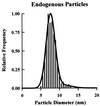Structural analysis of cloned plasma membrane proteins by freeze-fracture electron microscopy
- PMID: 9736719
- PMCID: PMC21625
- DOI: 10.1073/pnas.95.19.11235
Structural analysis of cloned plasma membrane proteins by freeze-fracture electron microscopy
Abstract
We have used freeze-fracture electron microscopy to examine the oligomeric structure and molecular asymmetry of integral plasma membrane proteins. Recombinant plasma membrane proteins were functionally expressed in Xenopus laevis oocytes, and the dimensions of their freeze-fracture particles were analyzed. To characterize the freeze-fracture particles, we compared the particle cross-sectional area of proteins with alpha-helical transmembrane domains (opsin, aquaporin 1, and a connexin) with their area obtained from existing maps calculated from two-dimensional crystals. We show that the cross-sectional area of the freeze-fracture particles corresponds to the area of the transmembrane domain of the protein, and that the protein cross-sectional area varies linearly with the number membrane-spanning helices. On average, each helix occupies 1.40 +/- 0.03 nm2. By using this information, we examined members from three classes of plasma membrane proteins: two ion channels, the cystic fibrosis transmembrane conductance regulator and connexin 50 hemi-channel; a water channel, the major intrinsic protein (the aquaporin 0); and a cotransporter, the Na+/glucose cotransporter. Our results suggest that the cystic fibrosis transmembrane conductance regulator is a dimer containing 25 +/- 2 transmembrane helices, connexin 50 is a hexamer containing 24 +/- 3 helices, the major intrinsic protein is a tetramer containing 24 +/- 3 helices, and the Na+/glucose cotransporter is an asymmetrical monomer containing 15 +/- 2 helices.
Figures




Similar articles
-
A method for determining the unitary functional capacity of cloned channels and transporters expressed in Xenopus laevis oocytes.J Membr Biol. 1995 Nov;148(1):65-78. doi: 10.1007/BF00234157. J Membr Biol. 1995. PMID: 8558603
-
Functional and morphological correlates of connexin50 expressed in Xenopus laevis oocytes.J Gen Physiol. 1999 Apr;113(4):507-24. doi: 10.1085/jgp.113.4.507. J Gen Physiol. 1999. PMID: 10102933 Free PMC article.
-
Oligomerization state of MIP proteins expressed in Xenopus oocytes as revealed by freeze-fracture electron-microscopy analysis.J Struct Biol. 1999 Dec 30;128(3):287-96. doi: 10.1006/jsbi.1999.4196. J Struct Biol. 1999. PMID: 10633068
-
Structure and function of the Na+/glucose cotransporter.Acta Physiol Scand Suppl. 1998 Aug;643:257-64. Acta Physiol Scand Suppl. 1998. PMID: 9789568 Review.
-
Structure of cardiac gap junction intercellular channels.J Struct Biol. 1998;121(2):231-45. doi: 10.1006/jsbi.1998.3972. J Struct Biol. 1998. PMID: 9615440 Review.
Cited by
-
The Human Sodium-Glucose Cotransporter (hSGLT1) Is a Disulfide-Bridged Homodimer with a Re-Entrant C-Terminal Loop.PLoS One. 2016 May 3;11(5):e0154589. doi: 10.1371/journal.pone.0154589. eCollection 2016. PLoS One. 2016. PMID: 27137918 Free PMC article.
-
Molecular organization and ATP-induced conformational changes of ABCA4, the photoreceptor-specific ABC transporter.Structure. 2013 May 7;21(5):854-60. doi: 10.1016/j.str.2013.03.001. Epub 2013 Apr 4. Structure. 2013. PMID: 23562398 Free PMC article.
-
Single-molecule recognition force spectroscopy of transmembrane transporters on living cells.Nat Protoc. 2011 Sep 1;6(9):1443-52. doi: 10.1038/nprot.2011.370. Nat Protoc. 2011. PMID: 21886107
-
The sodium/galactose symporter crystal structure is a dynamic, not so occluded state.Mol Biosyst. 2010 Jun;6(6):1040-6. doi: 10.1039/b927492h. Epub 2010 Mar 31. Mol Biosyst. 2010. PMID: 20358053 Free PMC article.
-
Exogenous expression of human SGLT1 exhibits aggregations in sodium dodecyl sulfate polyacrylamide gel electrophoresis.Am J Transl Res. 2013 May 24;5(4):441-9. Print 2013. Am J Transl Res. 2013. PMID: 23724167 Free PMC article.
References
-
- Ostermeier C, Michel H. Curr Opin Struct Biol. 1997;7:697–701. - PubMed
-
- Branton D. Philos Trans R Soc London B. 1971;261:133–138. - PubMed
-
- Staehelin L A, van der Staay G W M. In: Advances in Photosynthesis. Oxygenic Photosynthesis: The Light Reactions. Ort D R, Yocum C F, editors. Vol. 4. Dordrecht, The Netherlands: Kluwer; 1996. pp. 11–30.
-
- Costello M J, Viitanen P, Carrasco N, Foster D L, Kaback H R. J Biol Chem. 1984;259:15579–15586. - PubMed
Publication types
MeSH terms
Substances
Grants and funding
LinkOut - more resources
Full Text Sources
Other Literature Sources

